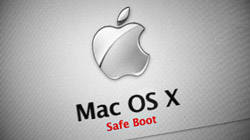How to Safe Boot to troubleshoot your Mac in Safe Mode

Many
Windows users are familiar with the F8 keystroke required to start
their PCs in Safe Mode for troubleshooting purposes. Mac users can do
the same, but in a slightly different way.
If your Mac is freezing, not starting up correctly, or behaving in
another odd way, you could be looking at several possible causes. For
example, a hardware failure, software glitch, or corrupt file might be
to blame. To help narrow down the possibilities and perhaps just gain
access to your files again, Safe Mode is a good place to start.Safe Booting Mac OS X disables many of the nonessential services and extensions that usually start up when a Mac is turned on. As a result, only the bare minimum components required to start the system are loaded. This lessens the chances that extraneous (and possibly corrupt) files will affect the process. Starting up in Safe Mode also does a directory check of the startup disk, disables non-system fonts, turns off hardware accelerated graphics, stops file sharing, and clears cache files that could be the root of your problems. These caches might be responsible for rare blue screens after certain software updates.
To start your Mac in Safe Mode, follow these easy steps:
- Shut down the computer completely.
- Press the power button to turn the computer on and hold the Shift key immediately after the startup chime is heard. This must be done quickly, so be prepared.
- Continue holding the Shift key until a gray progress indicator is displayed on the screen. After a couple minutes the system should bring you to a login screen that clearly states “Safe Boot”. Log in with your username and password.
